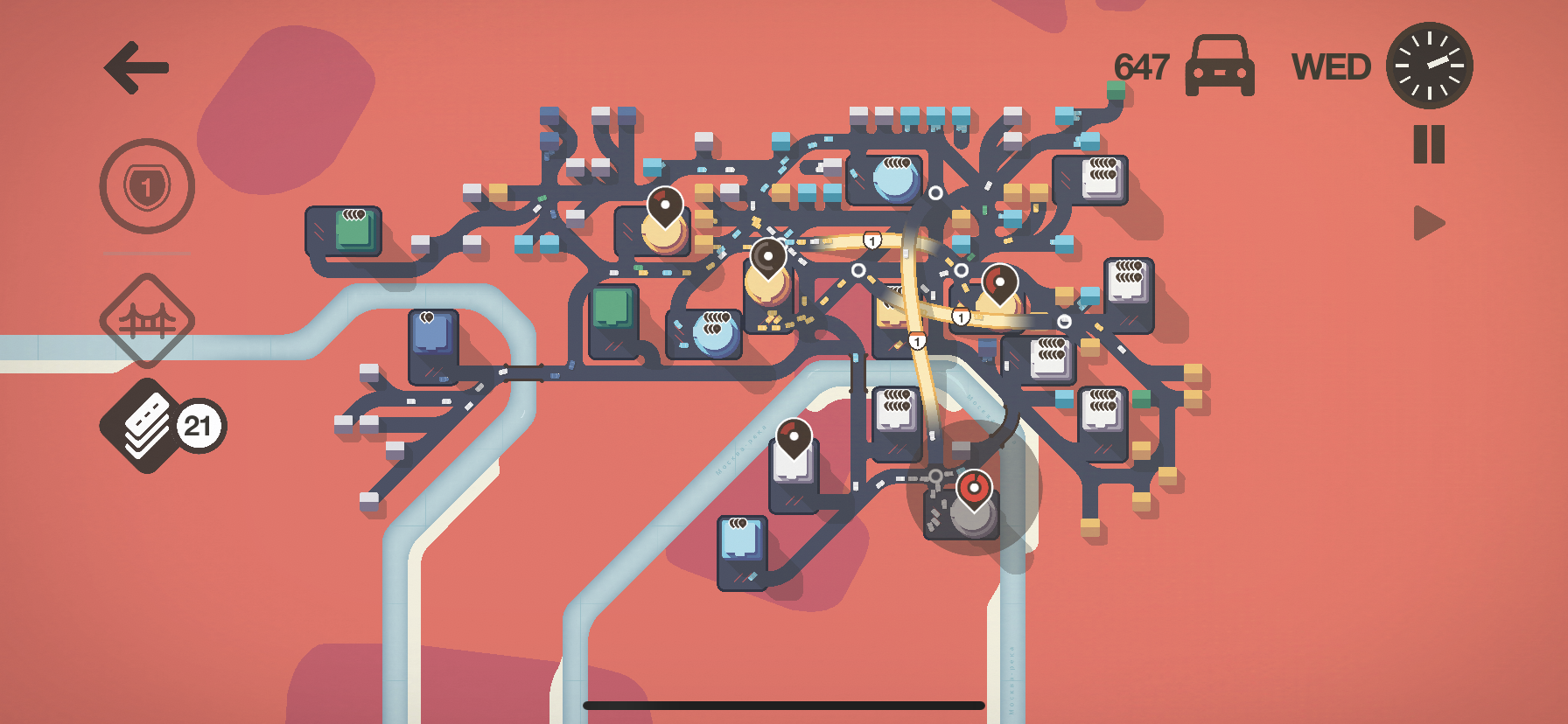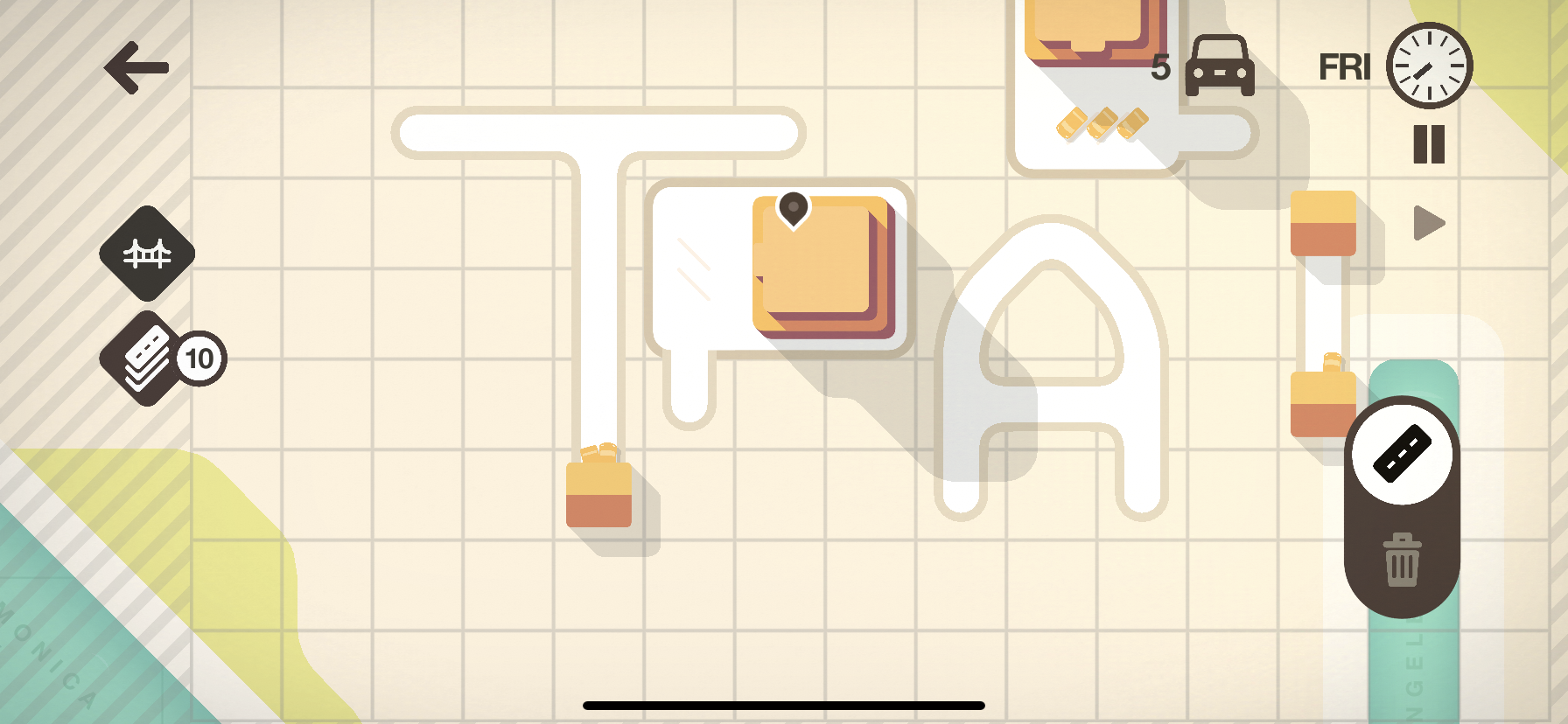In December of 2016, the other TouchArcade writers and I each posted our Top Ten lists detailing our favorite iOS games of that year. One of my top picks was Mini Metro, which I wrote was “an incredibly addictive little strategy game that has literally been the only thing on my iPad’s screen all week.” My life started to get really busy around that time and it wound up being the last thing I ever wrote for TouchArcade. Three years later, the newly released Apple Arcade has sucked me right back into iOS gaming and I couldn’t stay away from TA any longer. So what better game to review on my first day back than the sequel to one of the last games I ever wrote about?
Mini Motorways by Dinosaur Polo Club should look instantly familiar to anyone who loved Mini Metro. In fact, I didn’t even know it was coming out until I scrolled through the Apple Arcade section of the store last week and saw that familiar art style with the word “Mini” attached to the screenshots. It’s every bit as crisp, clean, and bright as the original looked, although not quite as minimalist this time around. There are shadows and topographical features now (or is that grass?) and a grid to help you place your mini motorways, and actual buildings that pop out of the ground instead of abstract lines and shapes. If Mini Metro looked like a subway map, Motorways looks a bit more like a board game. Overall it’s a very satisfying evolution of the previous game’s visuals that feels new and unique while still maintaining the feel of the original.

Also returning is the wonderful sound design that continues to perfectly compliment the distinct art style. The music is minimalist to the extreme, with simple chords droning softly in the background and seemingly random bleeps and bloops chiming away pleasantly as you plan your city. Some of the sounds aren’t random at all, and are meant to clue you in to certain events (a new building popping up, or the week ending, for example). One of my favorite cues is the extremely satisfying Waaahhhhhhh! when a new week begins.
Just because the music and sounds are relaxing doesn’t mean the game will put you to sleep, however. In fact, it can get downright stressful after 20 minutes or so. Just like in the first game, your goal in Mini Motorways is to connect points on the map with tracks (roads instead of rails this time) that will allow the unseen commuters to get where they need to go as efficiently as possible. If a building gets too clogged up with alerts (signaling a ride is needed), a timer will begin filling up. If you can’t get enough cars to that location and it fills entirely, it’s game over.

This being a sequel, of course, there are some important differences this time around. Since the game is all about roads and cars, you are no longer just connecting all the “stops” on a map; rather, you have to connect little houses (which contain cars) directly or indirectly to the larger buildings that share their color. Also, you have the freedom to draw roads any way you like instead of being limited to straight lines that snap into place like in Metro. This allows for a bit more freedom since you can draw multiple paths zig-zagging between any two points (or three, or four…), or even create your own roundabouts if you want. You can also attempt to draw main roads with shorter arterial paths branching off, and Dinosaur Polo Club’s algorithms seem to encourage this by often creating house-heavy suburban districts separate from areas with a lot of buildings. After each week you can choose a few upgrades for your city, too, like more roads and bridges (basically the same as the original game’s “tunnels”) or even a highway that allows for faster travel between two locations.
Another one of those upgrades is the traffic light, which in theory should alleviate congestion and make your roads run smoother. In practice, traffic lights seem to do absolutely nothing at best and actually make your roads even more congested at worst. This is where the game starts to show some rough edges, and it’s indicative of one of its biggest problems: the ‘rules’ the traffic follows are entirely unexplained, and most of the late game seems to rely on you understanding and anticipating how that traffic will move.

For example, if one road gets too congested, would it make sense to create a second longer road that gives some cars an alternate path? Will they take it, or will they stubbornly choose the shorter path that has a traffic jam? Even if you set up a test, it’s hard to tell since all the cars are coming from different places and by the time congestion starts to occur there are just too many to follow. This lack of clarity on how or why the cars choose to go where they go makes it incredibly tricky to come up with long-term strategies.
At first, for instance, I tried to make neat and orderly roads that mostly went in a straight grid pattern, but I soon found that haphazardly drawing crazy roads all over the place seemingly worked just as well most of the time. Contrast this with Mini Metro, which was always exceedingly clear on how every piece of the game worked. The subway cars would move and behave exactly the same way every time, and every loss felt like it was 100% my fault (with some RNG sprinkled in, of course). I could spend hours trying different strategies in that game and fully understand why each one worked or didn’t work, tweaking them to go just a little bit further next time, whereas in Motorways I usually end each game in roughly the same 500 to 800 score range as the last session no matter what random strategies I come up with.
There are also a few smaller problems that come with any new game, like various minor bugs (sometimes traffic will stop for no reason), UI challenges (I can’t count the number of times I opened the notification screen when drawing roads at the top of the level), a lack of content (only a handful of cities and a single mode to play), and no replay to share at the end of the level–one of my favorite features in the original. Still, those are pretty minor complaints that will almost certainly be resolved after a few updates. (In fact, the developers have mentioned they are looking into all of these issues–and the traffic lights–on Reddit.)
My biggest issue with the game, as I’ve said, is undoubtedly how much less clear it is with how traffic behaves than in Mini Metro, and how upgrades like the traffic light are supposed to help. I’m not ready to definitively say Mini Metro is better, though–it might just mean that Mini Motorways is a deeper game that I haven’t fully cracked yet. As it stands now, it’s still incredibly addicting and satisfying to play and very beautiful to look at and listen to. Even with the few problems I had, it’s certainly a top-tier Apple Arcade exclusive that shouldn’t be overlooked by fans of the original or newcomers to the series.
 Like this article?
Like this article?
We pride ourselves on delivering quality, long-form articles like this one instead of the SEO-driven click bait that is slowly taking over the internet. Unfortunately, articles like these rarely generate the traffic (and as a result, the ad revenue) of listicles, cheat guides, and other junk.
Please help us continue producing content like this by supporting TouchArcade on Patreon, doing your Amazon shopping by first visiting toucharcade.com/amazon, and/or making one-time contributions via PayPal.
NOTE: Mini Motorways is available exclusively as part of Apple Arcade, a premium gaming subscription service from Apple. Without being a subscriber to Apple Arcade you cannot download and play this game. Apple Arcade is $4.99 per month and does come with a free one month trial, you can learn more about it on Apple’s official website or by visiting our dedicated Apple Arcade forum.
from TouchArcade https://ift.tt/2n5vLgS
0 comments:
Post a Comment